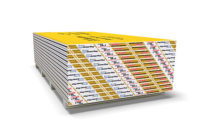As with most products under consideration for purchase, confidence and trust are ultimately the key influencers in one’s buying experience. And, choosing an EIFS fastening system is certainly no exception. One’s choice should be made only after thorough investigation and research, as that buying decision certainly has significant performance implications on the entire wall assembly.
Although EIFS washers are very similar in appearance, they truly are far more than round pieces of plastic with voids and holes. Legitimate ones are designed, engineered and manufactured for specific applications and should never be substituted for because of price, availability, expedience or random decision. They are also made available by reputable companies, with proven track records of reliability. Remember, this inexpensive washer and screw combination performs an incredibly important task: to keep a beautiful finished wall system off of your lawn, vehicle, and/or visitors and securely attached to its substrate for the lifetime of your building.
Using a Washer
For instance, when mechanically attaching polymer based (aka P.B.) EIFS, one must always incorporate a washer similar to that shown on Diagram A. The washer should be 2 inches in diameter and be made from virgin (not regrind) polypropylene. Angled keys for interlocking basecoat are a must, as is a recessed chamber, with a closure mechanism to prevent clogging. This acts as a thermal break and also allows for incidental wall movement, independent of the substrate. It must also possess a flat profile, so it seats (approximately 1/16 inches) without crushing the EPS, which compromises both its integrity and performance. It also ensures that the EPS properly compresses against the substrate to create an extremely important “gasket” effect. This diverts any potential moisture from entering the wall cavity where the fastener penetrates the substrate.
The above mentioned are simply qualifiers. None of it matters without independent, third party, witness testing for both positive and negative wind-loading. This is an absolute must to ensure that your wall meets the building design and wind-load criteria set forth by the local and national building codes. In-house testing is of absolutely no use to you the consumer/specifier. It lacks objectivity, code compliance, industry standards, as well as necessary checks and balances.
Continuous Insulation Systems
Diagram B depicts the proper washer for continuous insulation systems—such as Hunter XCI and Dow Thermax—polymer modified EIFS, modified stucco systems, fiberglass faced polyiso, extruded polystyrene, metal lath and stucco netting. It too should be made from virgin (not regrind) polypropylene and is 1¾ inches in diameter. Unlike the P.B. washer, it is manufactured with a slight camber, which needs the resistance of a more rigid insulation than EPS to flatten out for full contact with the surface of the rigid insulation it is attaching. (Note: This is not possible with EPS, as there is not enough resistance. This leads to crushing, which significantly compromises the system’s integrity and/or performance.)
As with P.B. washers, these plates also feature angle keys to interlock the basecoat. However, unlike the P.B. washer, they are engineered to allow for the fastener head to lay flush to the surface (no recess). Because they are designed to be utilized over extruded insulation boards and/or reinforcing mesh, “in-out” movement is minimized and fastener head popping is eliminated. (Note: These washers must only be used under these conditions. They are not designed as a P.B. EIFS washer and should not be utilized for P.B. EIFS installations.)
Pre-spotting
Diagram C represents the same washer as Diagram B, with the added feature of a central stem/tab for “pre-spotting” into an extruded insulation board immediately preceding screw installation. (Note: These washers must also only be used under these conditions. They are not designed as a P.B. EIFS washer and should not be utilized for P.B. EIFS installations.) Also, the stem/tab is not a thermal chamber, nor does it mitigate movement independent of the substrate.
As we in the EIFS industry are happy to report, the industry is experiencing healthy growth. It is a wonderful system that, when properly installed, provides beautiful aesthetics, energy efficiency and long-lasting performance. However, when compromised, as with an improper attachment method, the results can be both serious and dramatic. Therefore, I strongly suggest doing your homework and not cutting corners. Saving a few cents or a little time, while placing your building at risk, is never a prudent decision.





















